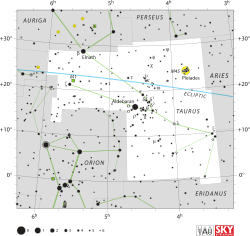Gamma Tauri

| |
| Observation data Epoch J2000 Equinox J2000 | |
|---|---|
| Constellation | Taurus |
| Right ascension | 04h 19m 47.6037s[1] |
| Declination | +15° 37′ 39.512″[1] |
| Apparent magnitude (V) | 3.654[2] |
| Characteristics | |
| Spectral type | G8III[3] |
| U−B color index | +0.84[4] |
| B−V color index | +0.99[4] |
| Astrometry | |
| Radial velocity (Rv) | 38.7 ± 0.9[5] km/s |
| Proper motion (μ) | RA: +115.29[1] mas/yr Dec.: -23.86[1] mas/yr |
| Parallax (π) | 21.17 ± 1.17[1] mas |
| Distance | 154 ± 9 ly (47 ± 3 pc) |
| Absolute magnitude (MV) | 0.22[3] |
| Details | |
| Mass | 2.70 ± 0.13[6] M☉ |
| Radius | 13.4 ± 0.2[7] R☉ |
| Luminosity | 85[3] L☉ |
| Surface gravity (log g) | 2.58-2.61[7] cgs |
| Temperature | 4,844 ± 47[7] K |
| Metallicity [Fe/H] | +0.11[8] dex |
| Rotation | 253 days[9] |
| Rotational velocity (v sin i) | 4[10] km/s |
| Age | 430–530[3][6] Myr |
| Other designations | |
Gamma Tauri (γ Tau, γ Tauri) is a star in the constellation Taurus and a member of the Hyades star cluster. It has the traditional name Hyadum I,[11] which is Latin for "First Hyad".
Gamma Tauri is a spectral class G8 or K0[2][3] giant star with an apparent magnitude of +3.65. It is located within about 2.5 parsecs of the center of the Hyades cluster—the nearest open cluster to the Sun. This star has passed through the main sequence phase is now on the red giant branch where it is using nuclear fusion of helium at its core to provide energy.[12] Age estimates for Gamma Tauri range from 430 million[3] to 530 million years.[6] By comparison, the age of the Hyades cluster is about 625 million years with an error margin of 50 million years.[13]
Based upon parallax measurements, Gamma Tauri is approximately 154 light years from Earth. The angular diameter of this star has been measured using the CHARA array to 2% accuracy. After correcting for limb darkening, this gives the stellar radius as 13.4 times the radius of the Sun.[7] The star is radiating about 85 times the luminosity of the Sun[3] and has 2.7 times the Sun's mass.[6] With its large size and low projected rotational velocity of 4 km s−1,[10] it takes about 253 days to complete a rotation.[9]
References
- 1 2 3 4 5 Perryman, M. A. C.; et al. (1997), "The Hipparcos Catalogue", Astronomy & Astrophysics, 323: L49–L52, Bibcode:1997A&A...323L..49P
- 1 2 3 "NSV 1553 - Variable Star". SIMBAD. Centre de Données astronomiques de Strasbourg. Retrieved 2009-09-22.
- 1 2 3 4 5 6 7 Takeda, Yoichi; Sato, Bun'ei; Murata, Daisuke (August 2008). "Stellar Parameters and Elemental Abundances of Late-G Giants". Publications of the Astronomical Society of Japan. 60 (4): 781–802. arXiv:0805.2434
 . Bibcode:2008PASJ...60..781T. doi:10.1093/pasj/60.4.781.
. Bibcode:2008PASJ...60..781T. doi:10.1093/pasj/60.4.781. - 1 2 Johnson, H. L.; Morgan, W. W. (1953). "Fundamental stellar photometry for standards of spectral type on the revised system of the Yerkes spectral atlas". Astrophysical Journal. 117: 313–352. Bibcode:1953ApJ...117..313J. doi:10.1086/145697.
- ↑ Evans, D. S. (June 20–24, 1966). "The Revision of the General Catalogue of Radial Velocities". In Batten, Alan Henry; Heard, John Frederick. Determination of Radial Velocities and their Applications, Proceedings from IAU Symposium no. 30. University of Toronto: International Astronomical Union. Retrieved 2009-09-10.
- 1 2 3 4 da Silva, L.; et al. (November 2006). "Basic physical parameters of a selected sample of evolved stars". Astronomy and Astrophysics. 458 (2): 609–623. arXiv:astro-ph/0608160
 . Bibcode:2006A&A...458..609D. doi:10.1051/0004-6361:20065105.
. Bibcode:2006A&A...458..609D. doi:10.1051/0004-6361:20065105. - 1 2 3 4 Boyajian, Tabetha S.; et al. (February 2009). "Angular Diameters of the Hyades Giants Measured with the CHARA Array". The Astrophysical Journal. 691 (2): 1243–1247. arXiv:0810.2238
 . Bibcode:2009ApJ...691.1243B. doi:10.1088/0004-637X/691/2/1243.
. Bibcode:2009ApJ...691.1243B. doi:10.1088/0004-637X/691/2/1243. - ↑ Soubiran, C.; Bienaymé, O.; Mishenina, T. V.; Kovtyukh, V. V. (March 2008). "Vertical distribution of Galactic disk stars. IV. AMR and AVR from clump giants". Astronomy and Astrophysics. 480 (1): 91–101. arXiv:0712.1370
 . Bibcode:2008A&A...480...91S. doi:10.1051/0004-6361:20078788.
. Bibcode:2008A&A...480...91S. doi:10.1051/0004-6361:20078788. - 1 2 Setiawan, J.; et al. (July 2004), "Precise radial velocity measurements of G and K giants. Multiple systems and variability trend along the Red Giant Branch", Astronomy and Astrophysics, 421: 241–254, Bibcode:2004A&A...421..241S, doi:10.1051/0004-6361:20041042-1
- 1 2 Bernacca, P. L.; Perinotto, M. (1970). "A catalogue of stellar rotational velocities". Contributi Osservatorio Astronomico di Padova in Asiago. 239 (1). Bibcode:1970CoAsi.239....1B.
- 1 2 Allen, R. H. (1963). Star Names: Their Lore and Meaning (Reprint ed.). New York, NY: Dover Publications Inc. p. 390. ISBN 0-486-21079-0.
- ↑ de Bruijne, J. H. J.; Hoogerwerf, R.; de Zeeuw, P. T. (February 2001). "A Hipparcos study of the Hyades open cluster. Improved colour-absolute magnitude and Hertzsprung-Russell diagrams". Astronomy and Astrophysics. 367 (1): 111–147. arXiv:astro-ph/0011565
 . Bibcode:2001A&A...367..111D. doi:10.1051/0004-6361:20000410.
. Bibcode:2001A&A...367..111D. doi:10.1051/0004-6361:20000410. - ↑ da Silva, L.; et al. (November 2006). "Basic physical parameters of a selected sample of evolved stars". Astronomy and Astrophysics. 458 (2): 609–623. arXiv:astro-ph/0608160
 . Bibcode:2006A&A...458..609D. doi:10.1051/0004-6361:20065105.
. Bibcode:2006A&A...458..609D. doi:10.1051/0004-6361:20065105.